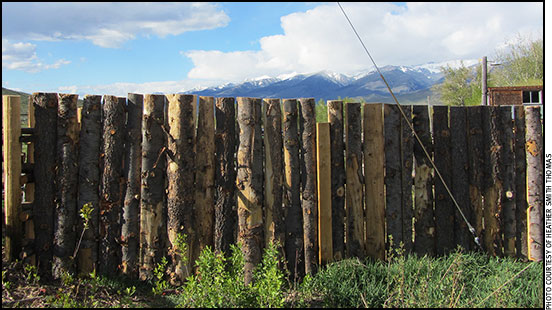MANAGEMENT...

Windbreaks for Fall-calving Herds
Ag engineer offers tips for building both stationary and portable windbreaks.
In climates where wind chill is an issue, creating windbreaks can save stockmen money in reduced feed costs, reduced illness and health costs, reduced loss of body condition, and increased growth for young animals.
Shelter is important for fall-calving herds, says Joseph Darrington, ag engineer at South Dakota State University. “There are two main types — natural shelter using trees/planted shelterbelts and constructed windbreaks. If you plant a shelterbelt, have a couple rows of tall trees and a couple rows of smaller trees.”
For maximum protection during winter and spring, it helps to include some evergreens that won’t lose their leaves. Read more.
Tips on Barn Lighting and Electricity
Adequate, efficient lighting is important for calving barns, machine shops and other farm/ranch facilities.
It pays to figure out what type of lights you want and where — whether you are improving an existing barn or building a new one. Rob Rulison, RMS Electric, Saint Johns, Mich., has done extensive work on agricultural facilities and says people need a plan for the electrical set-up, whether it be lighting, power sources, water heaters, fans for cooling, feed rooms, etc.
“This all needs to be taken into consideration regarding size of circuitry supplying the barn — whether it will be a 60-amp electrical panel or a 200-amp electrical panel,” he explains.
An important system design feature is ensuring proper placement of electrical fixtures to prevent livestock from damaging them and, in the process, possibly injuring the animal and/or causing electrical problems. Anything that is exposed, where an animal could rub on it, chew on it or kick it, should be encased in metallic conduit, advises Rulison. Read more.
Ensuring Bull Fertility
Sire fertility is crucial to breeding program success.
Much of a cow herd’s genetic potential lies with its herd sires, making bull fertility a vital component of an operation’s breeding program. John Kastelic, professor of animal reproduction and head of the Department of Production Animal Health at the University of Calgary Faculty of Veterinary Medicine, explained the importance of producing and selecting healthy bulls at the Applied Reproductive Strategies in Beef Cattle (ARSBC) symposium Aug. 30.
Nutrition until 25-30 weeks of age can ultimately determine the reproductive health of a bull, Kastelic said. If bulls are fed at a moderate level up to 30 weeks of age, it not only optimizes the growth of the bull, but also his reproductive potential, he said. Read more.
Cut Costs with Stockpiled Forages
Stockpiled forages reduce need, cost of hay, supplemental feed.
Stockpiled forages and winter annuals can reduce the need for and cost of hay and other supplemental feed for beef cattle producers in regions with adequate annual rainfall, said a Texas A&M AgriLife Extension Service expert.
Jason Banta, AgriLife Extension beef cattle specialist in Overton, said producers can reduce the need for hay and supplements by providing stockpiled forage mid-November through December and winter annuals October through May.
“If they choose these options, we want them to know how to best utilize them,” Banta said. Read more.
Benefits of Humane Cattle Handling
There are multiple benefits of humane cattle handling when vaccinating, preg-checking, sorting, weaning, etc.
The past three decades have seen a growing educational movement in low-stress handling and humane treatment of cattle. Temple Grandin, Colorado State University, has been instrumental in developing many user-friendly facilities and in educating producers about low-stress handling.
She says there is still a wide gap between stockmen who handle cattle quietly and calmly and those who don’t.
“There are still some people who can’t stop yelling at cattle. The percentage of people who are good at handling cattle has probably tripled, but there are still a few who are just as bad as ever,” says Grandin. Those “bad actors” apparently don’t realize the many benefits of humane handling. Read more.

Kris Ringwall
Beef Talk
The world is good, but sometimes saying that is hard. Remember that tomorrow is another day filled with hope.
Sometimes, words are really difficult as events shake our foundation.
Questions without answers abound. Words of hope and encouragement fall by the wayside. Our world simply stops. We stop, ponder and question. However, on the range or any place that maintains the living, the world may pause, but it does not stop. We may look to pause, to simply get away.
Unexpected events bring that emotion forward, generally when something is wrong, very wrong. We all have this innate feeling, a feeling of emptiness, of loss without a fix. We cannot go back; we cannot change what has happened. We simply may sit at a gate, looking back, but it’s a gate that will not open. Read more.
Angus Advisor
Click here for November herd management tips from cattle experts across the nation. Advice separated by region.
[Click here to go to the top of the page.]






